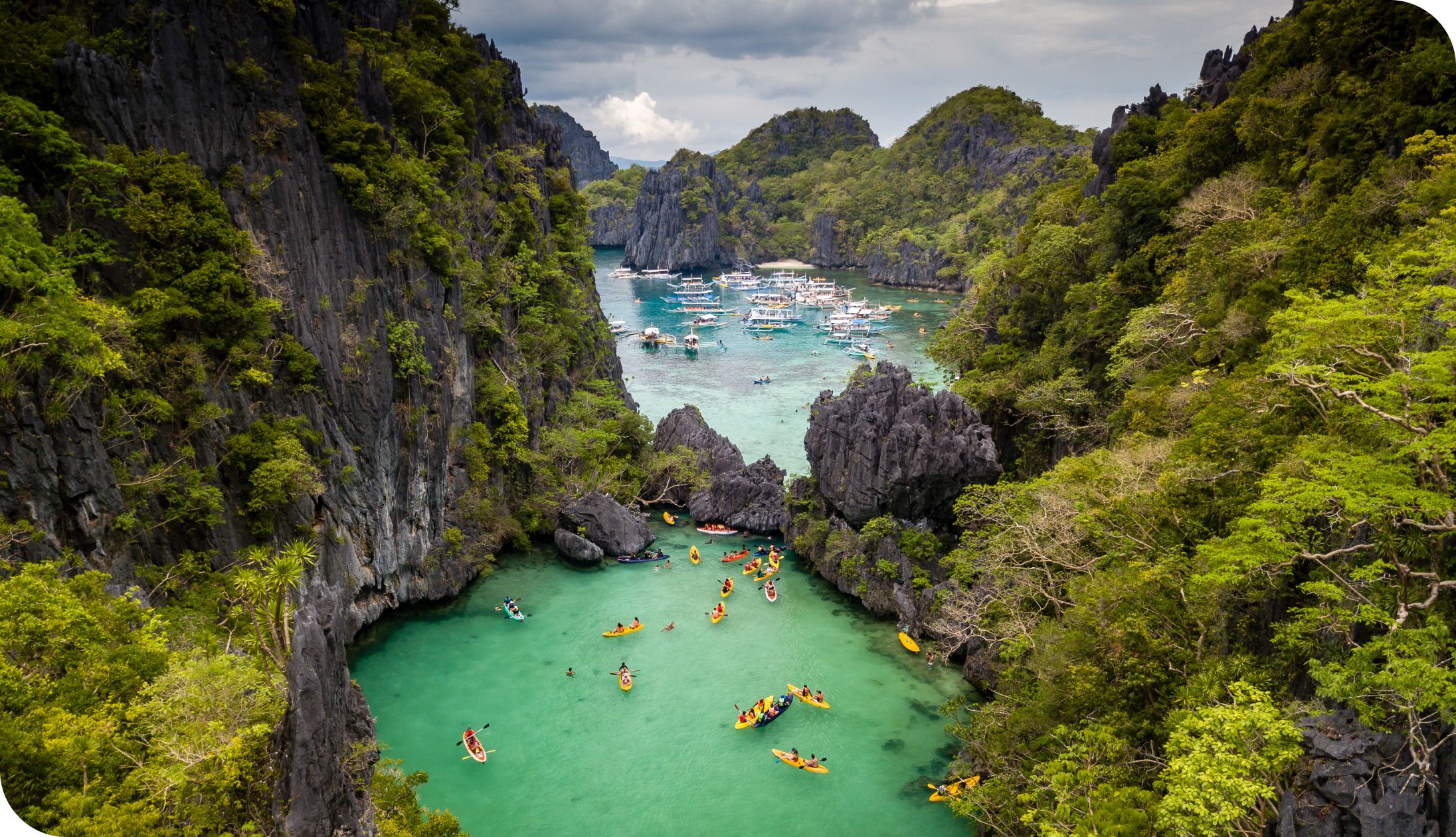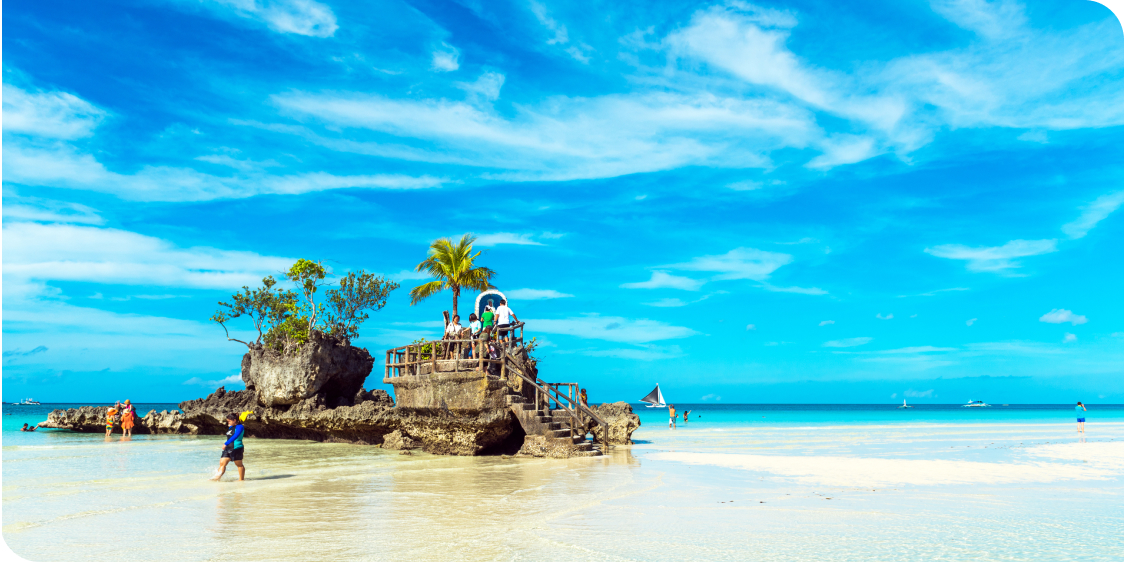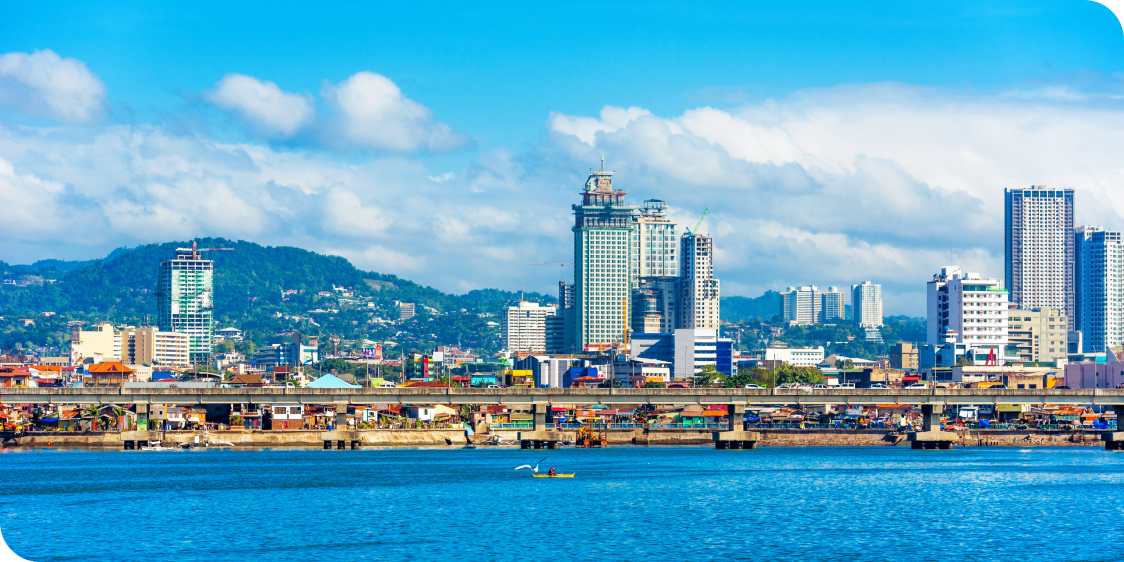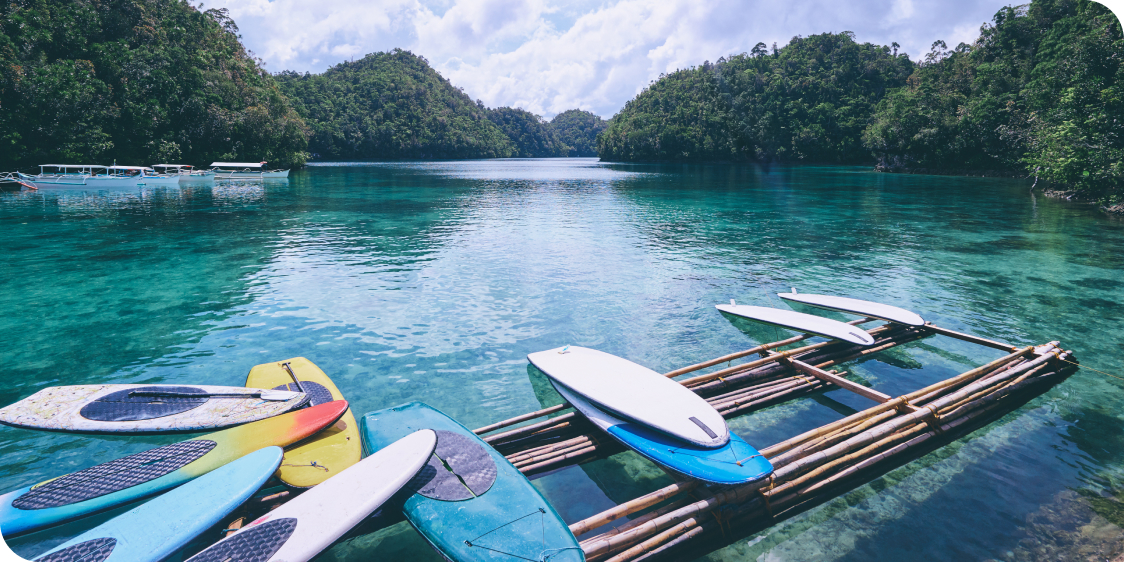
Backpacking in the Philippines offers a tropical adventure without the hefty price tag. This Southeast Asian archipelago of over 7,000 popular islands boasts turquoise waters, lush jungles, and vibrant culture, all remarkably budget-friendly.
If you’re planning a Philippines backpacking trip, one of your first questions is likely: How much will it cost to backpack the Philippines?
The good news is that budget travel in the Philippines is very achievable. In fact, the Philippines is one of the world’s most incredible budget travel destinations, with perfect white-sand beaches, mesmerising sunsets, friendly locals, and relaxed tropical vibes all at a fraction of the cost you might expect.
Some intrepid travellers report that the cost to backpack the Philippines can be as low as $20 (around ₱1,100) per day if you’re extremely frugal including hitchhiking, camping, and sticking to street foods. A more comfortable backpacker budget is still modest, around $35 - 40 (₱2,000) per day, which allows for hostel stays, local meals, and the occasional tour.
It is better to have a clear idea of how to plan your budget, if you’re island-hopping for two weeks or embarking on a 3-month backpacking route across the Philippines.
Why Backpack in the Philippines?
Why backpack in the Philippines? The reason, this country is a backpacker’s dream. The Philippines offers a unique blend of natural beauty, cultural richness, and affordability that’s difficult to compare.
You can hop between popular islands like Palawan, Cebu, Boracay, and Siargao, each with its own character. You can snorkel across coral reefs, surf world-class waves, trek through rice terraces and volcanoes, and even swing in a hammock under the palms.
Many of these experiences cost little to nothing, where beaches and waterfalls often have minimal fees, if any.
And for those coming from the UK or Europe’s typical backpacking community, the Philippines offers an off-the-beaten-path vibe compared to the more trodden routes in mainland Southeast Asia. It’s an adventure where you can still find quiet islands and authentic experiences away from huge tourist crowds.
Key Factors That Influence Backpacking Costs in the Philippines
Several key factors will shape your budget in the Philippines. Knowing these will help you plan realistically and find ways to save:
Travel Style
- Accommodation: Dorm beds in basic hostels start at around ₱300 - ₱400 (£4 - £6) per night, and some fan-cooled rooms or beach hammocks are even cheaper. Budget travellers can often find beachfront huts or homestays for a fraction of what you’d pay in other Southeast Asian destinations. However, if you prefer a private room or an air-conditioned hotel, expect to pay between ₱1,000 - ₱1,500 (£15 - £22). In tourist hotspots like Boracay or Manila, even modest hotels can charge ₱3,000–₱5,000 a night, especially during peak season.
- Food and Drink: Street food and casual eateries serve satisfying meals for ₱50 - ₱200 (£0.70 - £3). Dishes like adobo, lumpia, or arroz caldo can be tasty, filling, and budget-friendly. On the other hand, tourist restaurants and Western-style cafés can cost ₱300 - ₱500 per meal. Alcohol varies too; local beers are cheap at ₱60–₱80, while imported drinks and cocktails at resort bars will cost much more, and sometimes they can easily exceed ₱1,000.
- Activities: Many of the Philippines’ natural attractions, such as the beaches, waterfalls, and hiking trails, are free or cost very little to enjoy. But organised activities do add up. Island-hopping tours cost ₱1,200, ₱1,500 per day, diving ranges from ₱1,500 - ₱3,000 per session, and surf lessons in Siargao are around ₱500 - ₱600 an hour. These are fantastic experiences but require budgeting ahead.
Length of Stay
The longer your trip, the more your daily expenses can balance out. Short trips often involve fast-paced travel, multiple domestic flights, and packed itineraries, which can drive up the cost per day. In contrast, a three-month stay allows for slower travel, using ferries and buses rather than planes, and better deals on long-term accommodation.
However, staying longer comes with additional considerations. UK citizens can stay visa-free for 30 days, but extensions are required beyond that. A 29-day extension costs about ₱2,000 - ₱3,000, while a further 60-day extension (including fees and ACR card) can add ₱7,000 - ₱10,000. Be sure to factor this into your long-term travel budget.
Regions Visited
- Urban vs. Rural: Major cities like Manila and Cebu offer a broad price range. You’ll find budget-friendly hostels (₱500) and cheap local meals (₱100), but also premium restaurants, malls, and hotels that can stretch your budget. Upscale areas such as Makati or Bonifacio Global City are particularly expensive, where a single cocktail or coffee might rival London prices. While Manila has its conveniences, most budget travellers find it crowded, costly, and best kept to a minimum.
- Tourist Hotspots: Destinations like Boracay and El Nido are beautiful but come with higher costs due to their popularity. Boracay, after recent redevelopment, now leans towards mid-range and luxury travel. Daily costs can reach ₱3,500+ (around £50+), and even hostel beds often start at ₱800.
- Offbeat Destinations: Quieter places like Siargao, Camiguin, Sagada, and Negros offer excellent savings and more authentic experiences. Here, hostels and homestays often range between ₱400 - ₱600, meals are cheap, and natural attractions such as waterfalls, caves, and rice terraces are typically free or very low-cost.
Time of Year
- Peak Season (December to April) aligns with the dry season and major holidays like Christmas and Easter. It's the most expensive time to travel. Accommodation rates and tour prices surge due to high demand, and popular routes often sell out early.
- Low Season: (June to October) falls during the rainy southwest monsoon. It’s quieter and cheaper, with fewer tourists and frequent deals on hostels, ferries, and domestic flights. While you may experience storms or heavy downpours, many travellers find sunny intervals and bargain pricing worth the trade-off. A tour priced at ₱1,500 in January might drop to ₱1,200 in July.
- Shoulder Seasons: (May and November) offer the best of both worlds. The weather is often pleasant, crowds are thinner, and you can still enjoy low-season rates without the full impact of the rains.
Daily Budget Overview
So, what’s the daily budget you should expect as a backpacker in the Philippines?
While it of course varies by person and style, here’s an overview of typical daily budget ranges for different travel styles:
1. Shoestring Backpacker
- Cost (PHP/day): ₱1,200 – ₱1,800
- Cost (Approx. in GBP/day): £17 – £25
- Who is it for: Ideal for ultra-budget travellers. Accommodation includes basic hostel dorm beds, hammocks, or beach huts. Meals are mostly street food or local market groceries. Transport is local (jeepneys, tricycles, buses), and activities are low-cost or free. Expect basic facilities (e.g. fan rooms, cold-water showers) and a no-frills but adventurous experience.
2. Budget / Average Backpacker
- Cost (PHP/day): ₱2,500 – ₱3,500
- Cost (Approx. in GBP/day): £35 – £50
- Who is it for: A balanced range for most backpackers. You’ll stay in dorms or budget private rooms, eat at local restaurants with occasional café treats, and enjoy a few tours or activities. Transport between islands and regions is affordable, allowing you to explore more freely without breaking the bank. A popular budget bracket for backpackers across Southeast Asia.
3. Flashpacker / Comfort Traveller
- Cost (PHP/day): ₱5,000+
- Cost (Approx. in GBP/day): £70+
- Who is it for: For those who prefer more comfort, private en-suite rooms with air condition, faster inter-island flights, more frequent paid activities like diving or upscale tours, and dining at restaurants are all within reach. This budget suits digital nomads, couples, or those combining backpacking with higher-end travel. Great value for a relaxed, upgraded experience in the Philippines.
Cost Breakdown by Category
Now let’s look at the backpacking costs in the Philippines category by category. This will help you understand what you’re likely to spend on accommodation, food, transport, activities, everyday necessities, and travel insurance and some basic backpackers essentials.
1. Accommodation
The Philippines offers exceptional value for accommodation, with options to suit every budget level. Hostel dorm beds are your most economical choice, typically costing ₱300-₱700 per night (£4-£10). In popular backpacker destinations like El Nido or Coron, you can find basic fan-cooled dorms for as little as ₱330 ($6), whilst air-conditioned options in high-demand areas might reach ₱700.
2. Food & Drink
Filipino cuisine offers incredible value for budget-conscious travellers willing to eat like locals. Street food and local eateries provide the best bargains and authentic cultural experiences. Street snacks like fish balls, kikiam, and squid balls cost just ₱5 - ₱20 each, whilst barbecued pork or chicken sticks run ₱20 - ₱30. At local carinderias, complete meals with rice and multiple dishes cost ₱80 - ₱150 total, meaning you can eat a filling meal for under £2.
Beverages require careful budgeting since tap water isn't potable. Bottled water costs ₱30-₱40 per 1.5L bottle, adding up to ₱60 daily for adequate hydration. Many Filipino eateries provide free filtered drinking water, eliminating the need to constantly purchase bottled beverages.
3. Transportation
Philippine transport remains remarkably affordable, especially when using local options. Jeepneys, the iconic converted jeeps, cost merely ₱8 - ₱20 per ride (about £0.15 for short hops).
Tricycles (motorbike taxis with sidecars) are slightly pricier at ₱20-₱50 for shared rides or ₱100+ for solo charters. Always negotiate fares beforehand.
Inter-island ferries provide the backbone of Philippine transport, ranging from ₱300-₱1,500 depending on distance and vessel class. Short pump boat rides to nearby islands cost under ₱100, whilst longer routes like Coron to El Nido run ₱1,700-₱1,800 for 3.5-hour fast boats.
Domestic flights offer time-saving options when booked strategically. Budget airlines frequently run promotional fares as low as ₱600-₱1,500 one-way, though typical advance bookings cost ₱2,000-₱4,000 (£30-£60).
Scooter rentals provide excellent value for island exploration at ₱350-₱500 daily (£6-£8), with longer rentals often cheaper at ₱300/day weekly rates.
4. Activities & Entertainment
The Philippines excels as a natural playground where many experiences cost little or nothing. Beach access, hiking trails, and swimming are typically free, with some maintained sites charging token entrance fees of ₱50-₱200. Historic towns, centuries-old churches, and cultural sites often request donations rather than fixed fees.
Island hopping tours represent exceptional value, typically costing ₱1,200-₱1,500 per person, including lunch and snorkelling equipment. Diving opportunities showcase the Philippines' underwater treasures affordably.
Backpacker Travel Insurance
Backpacker insurance is a non-negotiable part of your Philippines backpacking budget. With so many adventure activities, island transfers, and potential medical risks, having cover gives you peace of mind. Backpackers Travel Insurance costs start at £280 for a three month trip and protects you against trip cancellations, injuries, theft, and more.
Gigasure is a great option for backpackers, offering flexible, affordable cover tailored for their needs. You can customise your policy by adding adventure sports or removing certain benefits to save money. Our user-friendly app makes it easy to get support, submit claims, and manage everything on the go.
Examples of Cost Breakdown by Region
To give you a more concrete sense of backpacking costs, let’s examine a few specific destinations in the Philippines. Expenses can vary by region, so here are examples of what a backpacker might spend in Palawan, Boracay, Cebu, Siargao, and Manila. These aren’t strict budgets, but illustrative breakdowns reflecting typical costs in each place.
- Palawan
- Boracay
- Cebu
- Siargao
- Manila
1. Palawan (El Nido & Coron)
Daily Budget: ₱1,200 - ₱1,800
Palawan stands as the crown jewel of Philippine tourism, renowned for its dramatic limestone islands and crystal-clear waters that have captivated travellers worldwide. Despite its growing popularity, this tropical paradise remains surprisingly budget-friendly for backpackers who venture beyond the main tourist strips. The region offers an incredible diversity of experiences, from exploring hidden lagoons to lounging on pristine beaches.
Accommodation options are abundant and affordable throughout Palawan. In El Nido town, hostel dorm beds typically cost ₱500–₱600, though savvy travellers can find even cheaper options at around ₱330 per night. For those seeking a more authentic experience, smaller villages like Corong and Port Barton offer charming beach huts ranging from ₱400–₱800, often with the added bonus of ocean breezes.
Local dining provides exceptional value, with a full day's meals costing approximately ₱500. A typical day might include a hearty silog breakfast (garlic rice, egg, and meat) for ₱120, a fresh carinderia lunch featuring grilled fish, rice, and vegetables for ₱150, and a satisfying dinner at local eateries or street food BBQ stalls for ₱200. Don't miss trying halo-halo dessert for ₱50 or treating yourself to a refreshing fruit shake for ₱100.
Transportation within El Nido is largely walkable, though exploring nearby beaches might require renting a scooter for ₱500 daily or sharing tricycle rides at ₱50 each. The main expense comes from activities, particularly the famous island-hopping tours. Diving enthusiasts should budget extra for Coron's underwater experiences at approximately ₱1,500 per dive. Remember that ATMs are scarce outside major towns, so cash planning is essential.

2. Boracay
Daily Budget: ₱1,500 - ₱2,200
Boracay has earned its reputation as a premium destination, but budget-conscious travellers can still experience this iconic white-sand paradise with careful planning and strategic choices. The island's commercial development has driven prices higher than other Philippine destinations, yet affordable options exist for those willing to look beyond the main beach strip.
Accommodation costs start around ₱700–₱800 for hostel dorms, with many located a short 5-10 minute walk inland from White Beach. Near Station 2, expect to pay approximately ₱800 for decent hostel facilities. Off-season travellers or those willing to stay near Bulabog Beach might find options as low as ₱500. The island's compact size eliminates major transportation expenses, with e-trike rides costing just ₱20–₱40 along main routes.
Food expenses can be controlled by seeking local eateries inside alleys or the D'Talipapa market area, where meals range from ₱170–₱300. A daily food budget of ₱650–₱700 allows for local breakfast (₱150), carinderia lunch (₱200), and seafood BBQ dinner (₱300), with room for Boracay's famous fruit shakes at ₱160–₱220. Beach bars charge premium prices, with local beers at ₱100 and cocktails exceeding ₱200.
The island's greatest assets, stunning beaches like White Beach, Puka Shell Beach, and Diniwid Beach, are completely free to enjoy. However, numerous paid activities tempt visitors: island hopping tours (₱1,200), parasailing (₱1,000+), diving (₱2,000+ per dive), and the famous pub crawl (₱990). Strategic selection of one or two must-do activities helps maintain budget discipline while still experiencing Boracay's legendary appeal.

3. Cebu (City & Province)
Daily Budget: ₱1,050-₱1,550
Cebu offers remarkable versatility as both a bustling urban centre and gateway to incredible adventures, making it perfect for travellers seeking diverse experiences. The province combines city conveniences with natural wonders, from canyoneering at Kawasan Falls to swimming with whale sharks in Oslob.
Accommodation remains highly affordable throughout Cebu province. City hostels offer dorm beds for ₱400–₱600, while destinations like Moalboal provide similar rates at approximately ₱400. Even diving haven Malapascua offers basic lodging for ₱500–₱800. The province's extensive and inexpensive bus network connects major destinations: Cebu City to Moalboal costs ₱150, while routes to Oslob run about ₱180.
Adventure activities form the main expense category: canyoneering at Kawasan Falls (₱1,500), whale shark encounters in Oslob (₱1,000), and world-class diving (₱1,500 per dive).

4. Siargao
Daily Budget: ₱1,350-₱1,850
Siargao maintains its laid-back island charm while offering excellent value for money, particularly appealing to surf enthusiasts and those seeking authentic island life. This relatively undeveloped destination provides a refreshing contrast to more commercialised areas, though its remote location requires careful cash planning due to limited banking facilities.
Most travellers base themselves in General Luna, where hostel accommodations range from ₱500-₱700 for dorm beds with air conditioning. Budget-conscious travellers can find homestays with fan rooms and shared bathrooms for ₱300-₱400, while off-season rates might drop to ₱400 even for better facilities.
The island's relaxed dining scene balances local affordability with trendy options catering to digital nomads. Budget meals include pan de coco (coconut bread) and coffee for ₱50, adobo and rice lunches for ₱150, and fresh seafood dinners at local carinderias for ₱200. However, Instagram-worthy smoothie bowl cafes and Western restaurants command premium prices of ₱300+. Fresh coconuts after surfing sessions cost just ₱40.
Transportation typically involves scooter rentals at ₱350–₱400 daily, plus ₱100 for gas, essential for exploring hidden lagoons, rock pools, and surf breaks across the island. Alternative habal-habal rides cost ₱50 to Cloud 9 or ₱200 to Magpupungko rock pools one-way.
Surfing remains the primary activity, with lessons costing ₱500 or board rentals at ₱250 for half-day sessions.

5. Manila
Daily Budget: ₱1,150-₱1,650
As the Philippines' bustling capital and primary entry point, Manila offers urban experiences at surprisingly reasonable costs when avoiding tourist traps. This city of contrasts features everything from luxury hotels to street food stalls, providing budget travellers with authentic local experiences alongside world-class attractions.
Hostel accommodation ranges ₱400–₱600 across various districts from Malate to Makati, with competitive pricing throughout the metropolitan area. Makati's trendy hostels might cost ₱600–₱800 but offer modern facilities, while areas like Malate provide budget options around ₱500.
Manila's extensive public transportation network keeps movement costs minimal. LRT/MRT train rides cost ₱20–₱30, jeepneys charge approximately ₱10 per ride, and city buses range ₱10–₱30 depending on distance. While Grab rides offer convenience at ₱200–₱300 across town, strategic use of public transport can limit daily transportation costs to ₱100.
The city's food spectrum spans from ₱50 street food meals to expensive restaurants, but budget-conscious travellers can eat well for ₱500 daily. Options include Jollibee breakfasts or tapsilog at carinderias (₱100), street vendor lunches (₱150), and night market dinners (₱200).

Summary of Backpacking Costs in Philippines
1. Palawan (El Nido & Coron)
- Daily Budget Range (PHP): ₱1,200 - ₱1,800
- Approx Daily Budget (GBP): £17 - £25
- Example Accommodation Cost: ₱330–₱600 dorms, ₱400–₱800 beach huts
- Example Meal Cost: ₱500/day (local eateries and street food)
- Key Activities: Island-hopping (₱1,200), diving (₱1,500), free beaches
2. Cebu (City & Province)
- Daily Budget Range (PHP): ₱1,050 - ₱1,550
- Approx Daily Budget (GBP): £15 - £22
- Example Accommodation Cost: ₱400–₱600 city dorms, ₱500–₱800 in provinces
- Example Meal Cost: ₱500 - ₱600/day (lechon, BBQ, markets)
- Key Activities: Canyoneering (₱1,500), whale sharks (₱1,000), hikes
3. Siargao
- Daily Budget Range (PHP): ₱1,350 - ₱1,850
- Approx Daily Budget (GBP): £19 - £26
- Example Accommodation Cost: ₱300–₱700 hostels/homestays
- Example Meal Cost: ₱400 - ₱600/day (local food, coconuts, smoothies)
- Key Activities: Surfing (₱250–₱500), island tours (₱1,000+), lagoons
4. Manila
- Daily Budget Range (PHP): ₱1,150 - ₱1,650
- Approx Daily Budget (GBP): £16 - £23
- Example Accommodation Cost: ₱400–₱800 hostels in Makati/Malate
- Example Meal Cost: ₱500/day (Jollibee, Chinatown, street food)
- Key Activities: Museums, Intramuros, food tours, jeepneys (₱10–₱30 per ride)
Budgeting for a 3-Month Trip
If you’re planning a three-month backpacking trip in the Philippines, you’ll have ample time to immerse yourself. Long-term travel requires budgeting not just by the day but for the whole journey, including one-time costs.
Let’s put together an approximate budget for a 90-day adventure:
1. Accommodation
- Cost Range (3 months): ₱45,000 - ₱108,000 (£595 - £1,430)
- Details: Hostel dorm beds (₱400 - ₱600 per night) or private rooms (₱1,200+ per night). Budget assumes ₱800/day average - mix of 60 nights in dorms and 30 nights in private rooms for flexibility.
2. Food & Drinks
- Cost Range (3 months): ₱40,000 - ₱67,500 (£530 - £895)
- Details: Local street food and carinderia meals (₱300 - ₱500/day) to restaurant dining (₱600 - ₱750/day). Includes fresh coconuts, fruit shakes, and occasional beers. Cooking your meals can reduce costs significantly.
3. Transport (Domestic)
- Cost Range (3 months): ₱20,000 - ₱40,000 (£265 - £530)
- Details: Buses, ferries, and 2-3 domestic flights. Includes Manila-Coron flights (₱3,000), Cebu-Siargao flights (₱4,000), plus numerous island ferries and local jeepneys/tricycles. Slow travel with more boats reduces costs.
4. Activities & Tours
- Cost Range (3 months): ₱10,000 - ₱30,000 (£130 - £400)
- Details: Island hopping tours (₱1,200 each), diving (₱1,500 per dive), surfing lessons (₱1,500), canyoneering (₱1,500), whale shark tours (₱1,000), entrance fees, and equipment rentals. The budget allows 1-2 activities per week.
5. Visa Extension Fees
- Cost Range (3 months): ₱8,000 (£105)
- Details: Mandatory visa extensions for a 90-day stay. Covers the first 59-day extension and the second extension up to 89 days, including all processing fees. Fixed government cost.
6. Backpackers Insurance
- Cost Range (3 months): ₱21,479+ (£280+)
- Details: A 3-month Worldwide Backpackers insurance would start fat around £280. This policy is essential for medical emergencies.
7. Necessities & Miscellaneous
- Cost Range (3 months): ₱4,000 - ₱6,000 (£50 - £80)
- Details: SIM cards and data (₱1,000), toiletries and sunscreen, laundry (₱50/week), ATM fees (₱250 per withdrawal), emergency cash, and personal items. Roughly ₱45 - ₱65 per day buffer.
Total (90 days)
- Cost Range (3 months): ₱130,500 - ₱266,000 (£1,720 - £3,520)
- Details: Mid-range estimate: ₱193,000 (£2,550) for comfortable backpacking with flexibility for spontaneous experiences and occasional splurges.
Why is Travel Insurance Essential for Backpackers?
One thing you should never try to save money on by skimping entirely is travel insurance. Travel insurance is essential for backpackers exploring a place like the Philippines, where the combination of adventure activities and occasional setbacks makes insurance essential.
- Medical Emergencies & Evacuation: From minor illness to major accidents, hospital treatment in the Philippines can be expensive. Gigasure covers emergency care and evacuation, so if you break an ankle cliff-jumping or fall ill with dengue, you’re not facing thousands in unexpected costs.
- Lost or Stolen Belongings: Lost your phone on a bus or had your camera stolen? Gigasure’s gadget and baggage cover helps you recover the cost (after depreciation calculation) of your essentials, so you’re not left stranded.
- Trip Delays & Cancellations: Typhoons and ferry disruptions are part of island life. With Gigasure, you’ll be covered in line with your policy and the plan level you have purchased.
- Adventure Sports Add-ons: Planning to surf, dive, or go canyoning? Gigasure allows you to add cover for adventure activities instantly via the Gigasure app, perfect for spontaneous thrills.
- 24/7 Gigasure Assist Emergency Support: Whether it’s a late-night dental issue or a lost passport, Gigasure’s round-the-clock help means you’re never travelling alone.
Plan Your Philippines Backpacking Adventure with Gigasure
With all the insights and budgeting tips now in hand, you’re ready to start planning your unforgettable backpacking trip across the Philippines. From island-hopping in Palawan to surfing in Siargao, the possibilities are endless, and with a bit of prep, it’s all within reach. The key to a smooth experience is smart budgeting, flexible planning, and most importantly, reliable travel insurance.
Gigasure offers Travel Insurance specifically designed for adventurous travellers like you. Our customisable Backpackers cover ensures you’re protected from the unexpected, whether it’s a scooter accident, delayed ferry, lost gear, or a sudden illness in a remote island village.
And here’s where Gigasure can help with our user-friendly app that lets you manage everything on the go. You can update your Backpacker’s policy mid-trip if plans change (like adding scuba diving or gadget cover), make claims, or reach out to our 24/7 Gigasure Assist emergency team, all from your phone.
Take a moment to explore Gigasure’s Backpackers Insurance options and get a quote today. Then, download the app and get packing, your island-hopping adventure awaits!
Sources Used for Research:
- Skyscanner (skyscanner.com)
- Booking.com (booking.com)
- Numbeo (numbeo.com)
- Philippine Statistics Authority (psa.gov.ph)
- Tripadvisor (tripadvisor.co.uk)
- Blogs from travel communities (e.g., Reddit, Backpacker groups)
Disclaimer:
Backpacking costs in the Philippines vary depending on the season, and your personal travel style. Prices mentioned are averages based on current trends but may fluctuate. Always check up-to-date information before booking. Please make sure to always review your policy documents carefully to understand exactly what you're covered for.











